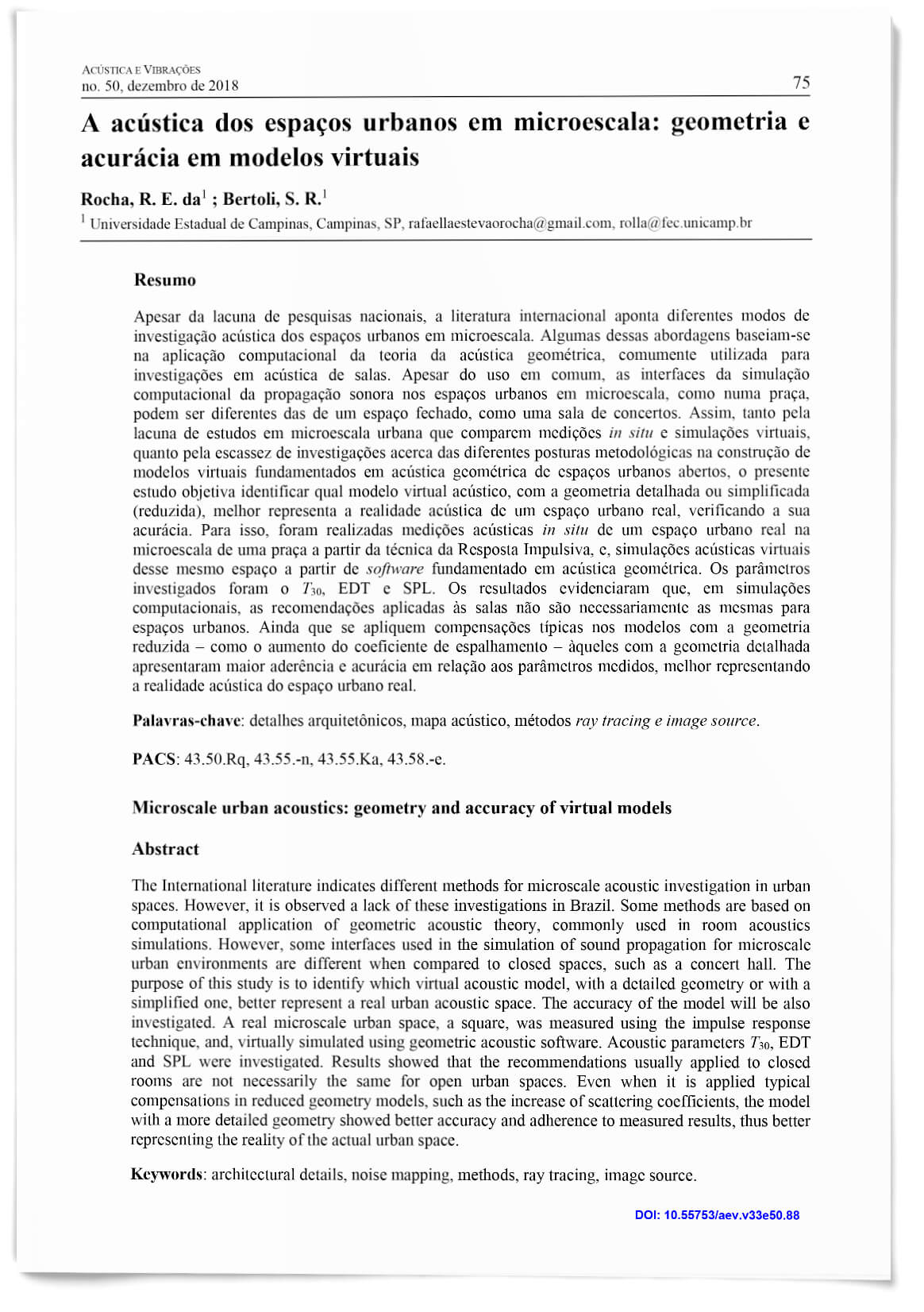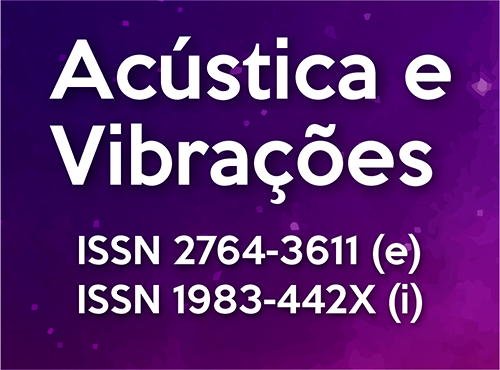A acústica dos espaços urbanos em microescala: geometria e acurácia em modelos virtuais
DOI:
https://doi.org/10.55753/aev.v33e50.88Palavras-chave:
detalhes arquitetônicos, mapa acústico, métodos ray tracing e image sourceResumo
Apesar da lacuna de pesquisas nacionais, a literatura internacional aponta diferentes modos de investigação acústica dos espaços urbanos em microescala. Algumas dessas abordagens baseiam-se na aplicação computacional da teoria da acústica geométrica, comumente utilizada para investigações em acústica de salas. Apesar do uso em comum, as interfaces da simulação computacional da propagação sonora nos espaços urbanos em microescala, como numa praça, podem ser diferentes das de um espaço fechado, como uma sala de concertos. Assim, tanto pela lacuna de estudos em microescala urbana que comparem medições in situ e simulações virtuais, quanto pela escassez de investigações acerca das diferentes posturas metodológicas na construção de modelos virtuais fundamentados em acústica geométrica de espaços urbanos abertos, o presente estudo objetiva identificar qual modelo virtual acústico, com a geometria detalhada ou simplificada (reduzida), melhor representa a realidade acústica de um espaço urbano real, verificando a sua acurácia. Para isso, foram realizadas medições acústicas in situ de um espaço urbano real na microescala de uma praça a partir da técnica da Resposta Impulsiva, e, simulações acústicas virtuais desse mesmo espaço a partir de software fundamentado em acústica geométrica. Os parâmetros investigados foram o T30, EDT e SPL. Os resultados evidenciaram que, em simulações computacionais, as recomendações aplicadas às salas não são necessariamente as mesmas para espaços urbanos. Ainda que se apliquem compensações típicas nos modelos com a geometria reduzida – como o aumento do coeficiente de espalhamento – àqueles com a geometria detalhada apresentaram maior aderência e acurácia em relação aos parâmetros medidos, melhor representando a realidade acústica do espaço urbano real.
Referências
KANG, J. Sound Propagation in Interconnected Urban Streets: A Parametric Study. Environment and Planning B: Planning and Design, v. 28, n. 2, p. 281–294, 2001. doi: 10.1068%2Fb2680 DOI: https://doi.org/10.1068/b2680
KANG, J. Urban sound environment. London: Taylor & Francis, 2007. doi: 10.1201/9781482265613 DOI: https://doi.org/10.1201/9781482265613
KANG, J.; MENG, Y.; BROWN, G. J. Sound propagation in micro-scale urban areas: simulation and animation. In: Euronoise, Nápoles, Itália: 2003.
ATTENBOROUGH, K.; LI, K.; HOROSHENKOV, K. Predicting outdoor sound. London: Taylor & Francis, 2007. doi: 10.1201/9781482295023 DOI: https://doi.org/10.1201/9781482295023
PROBST, W. Uncertainty and quality assurance in simulation software. In: Noise mapping in the EU models and procedures. Boca Raton: CRC Press, Taylor & Francis Group, 2013. doi: 10.1201/b12885 DOI: https://doi.org/10.1201/b12885
LYON, R. H. Role of multiple reflections and reverberation in urban noise propagation. The Journal of the Acoustical Society of America, v. 55, n. 3, p. 493–503, 1974. doi: 10.1121/1.1914527 DOI: https://doi.org/10.1121/1.1914527
DAVIES, H. G. Multiple‐reflection diffuse‐scattering model for noise propagation in streets. The Journal of the Acoustical Society of America, v. 64, n. 2, p. 517–521, 1978. doi: 10.1121/1.382002 DOI: https://doi.org/10.1121/1.382002
PICAUT, J.; SIMON, L. A scale model experiment for the study of sound propagation in urban areas. Applied Acoustics, v. 62, n. 3, p. 327–340, 2001. doi: 10.1016/S0003-682X(00)00028-1 DOI: https://doi.org/10.1016/S0003-682X(00)00028-1
KANG, J. Numerical modelling of the sound fields in urban streets with diffusely reflecting boundaries. Journal of Sound and Vibration, v. 258, n. 5, p. 793–813, 2002. doi: 10.1006/jsvi.2002.5150 DOI: https://doi.org/10.1006/jsvi.2002.5150
ONAGA, H.; RINDEL, J. H. Acoustic characteristics of urban streets in relation to scattering caused by building facades. Applied Acoustics, v. 68, n. 3, p. 310–325, 20075. doi: 10.1016/j.apacoust.2006.01.010 DOI: https://doi.org/10.1016/j.apacoust.2006.01.010
CAN, A.; FORTIN, N.; PICAUT, J. Accounting for the effect of diffuse reflections and fittings within street canyons, on the sound propagation predicted by ray tracing codes. Applied Acoustics, v. 96, p. 83–93, 2015. doi: 10.1016/j.apacoust.2015.03.013 DOI: https://doi.org/10.1016/j.apacoust.2015.03.013
EUROPEAN COMISSION. Good practice guide for strategic noise mapping and the production of associated data on noise exposure. WG-AEN. Versão 2. Versão final. 13 jan. 2006.
ROCHA, R. E. da; BERTOLI, S. R.; MAIORINO, A. V. Environmental noise performance: the detail of the building shape influence. In: Internoise, San Francisco, CA, USA: 2015. Disponível em: https://www.ingentaconnect.com/content/ince/incecp/2015/00000250/00000003/art00016
FASTL, H.; ZWICKER, E. Psychoacoustics: facts and models. 3. ed. Berlin; New York: Springer, 2007. DOI: https://doi.org/10.1007/978-3-540-68888-4
LICITRA, G.; MEMOLI, G. Limits and advantages of Good Practice Guide to noise mapping. In: Acoustic’08 Paris. Paris: 2008. DOI: https://doi.org/10.1121/1.2932687
KLÆBOE, R.; ENGELIEN, E.; STEINNES, M. Context Sensitive Noise Impact Mapping. Applied Acoustics, v. 67, n. 7, p. 620–642, jul. 2006. doi: 10.1016/j.apacoust.2005.12.002 DOI: https://doi.org/10.1016/j.apacoust.2005.12.002
ROCHA, R. E. da; BERTOLI, S. R. A acústica urbana e suas escalas de investigação. Acústica e Vibrações, v. 1, n. 48, p. 29–44, 2016.
TSAI, K.-T.; LIN, M.-D.; CHEN, Y.-H. Noise Mapping in Urban Environments: A Taiwan Study. Applied Acoustics, v. 70, n. 7, p. 964–972, 2008. doi: 10.1016/j.apacoust.2008.11.001 DOI: https://doi.org/10.1016/j.apacoust.2008.11.001
HORNIKX, M. Ten questions concerning computational urban acoustics. Building and Environment, p. 1–13, 2016. doi: 10.1016/j.buildenv.2016.06.028 DOI: https://doi.org/10.1016/j.buildenv.2016.06.028
HOWARTH, M. J.; LAM, Y. W. An assessment of the accuracy of a hybrid room acoustics model with surface diffusion facility. Applied Acoustics, v. 60, n. 2, p. 237–251, 2000. doi: 10.1016/S0003-682X(99)00059-6 DOI: https://doi.org/10.1016/S0003-682X(99)00059-6
KUTTRUFF, H. Room acoustics. 5. ed. Boca Raton: CRC Press, 2009. doi: 10.1201/9781482266450 DOI: https://doi.org/10.1201/9781482266450
CHRISTENSEN, C. L.; KOUTSOURIS, G.; GIL, J. ODEON room acoustics software version 13: user’s manual. Denmark: ODEON S/A, Scion DTU, 2016.
BORK, I. A comparison of room simulation software - the 2nd Round Robin on room acoustical computer simulation. Acta Acustica united with Acustica, v. 86, n. 6, p. 943–956, 2000.
BORK, I. Report on the 3rd Round Robin on Room Acoustical Computer Simulation – Part I: Measurements. Acta Acustica united with Acustica, v. 91, n. 4, p. 740–752, 1 jul. 2005.
VORLÄNDER, M. Internacional Round Robin on room acoustical computer simulations. In: ICA, Trondheim, Noruega: 1995.
ROCHA, R. E. da; BERTOLI, S. R. Outros olhares para o espaço urbano em microescala: uma revisão narrativa de simulações virtuais fundamentadas em acústica geométrica. In: XXVIII Encontro da SOBRAC, Porto Alegre, RS: 2018. doi: 10.17648/sobrac-87030 DOI: https://doi.org/10.17648/sobrac-87030
ROCHA, R. E. da; BERTOLI, S. R.; MAIORINO, A. V. Reducing geometry or detailing? Comparison between measured and modeled microscale urban spaces. POMA/ASA, v. 28, n. 015011, 2017. doi: 10.1121/2.0000391 DOI: https://doi.org/10.1121/2.0000391
ROCHA, R. E. da; MAIORINO, A. V.; BERTOLI, S. R. Accuracy of computer simulation software using hybrid models for microscale urban environments. POMA/ASA v. 28, n. 015012, 2017. doi: 10.1121/2.0000412 DOI: https://doi.org/10.1121/2.0000412
EL DIEN HH, WOLOSZYN P. The acoustical influence of balcony depth and parapet form: experiments and simulations. Applied Acoustics. v. 66, n.2, p.533–51, 2005. doi: 10.1016/j.apacoust.2004.09.004 DOI: https://doi.org/10.1016/j.apacoust.2004.09.004
MORI J, YOSHINO D, SATOH F, TACHIBANA H. Prediction of outdoor sound propagation by applying geometrical sound simulation technique. In: Internoise. Osaka, Japão:2011
MORI J, SATOH F, YOKOYAMA S, TACHIBANA H. Prediction of outdoor sound propagation by geometrical computer modeling. Acoustical Science and Technology. v.35, n.1,p.50-54, 2014. doi: 10.1250/ast.35.50 DOI: https://doi.org/10.1250/ast.35.50
PAINI D, GADE AC, RINDEL JH. Agorá acoustics - Effects of arcades on the acoustics of public squares. In: Forum Acoustics, p. 1813–8. Budapeste, Hungria; 2005.
MORI J, YOSHINO D, SATOH F, TACHIBANA H. Prediction of outdoor sound propagation by applying geometrical sound simulation technique. In: Internoise, p. 3079–83. Osaka, Japão: 2011.
BORK, I. A comparison of room simulation software - the 2nd Round Robin on room acoustical computer simulation. Acta Acustica united with Acustica, v. 86, n. 6, p. 943–956, 2000.
LISA, M.; HOLGER RINDEL, J.; CHRISTENSEN, C. L. Predicting the acoustics of ancient open-air theatres: the importance of calculation methods and geometrical details. In: BNAM, Mariehamn, Finlândia. Anais... In: BNAM. Mariehamn, Finlândia: 2004. Disponível em: https://citeseerx.ist.psu.edu/viewdoc/summary?doi=10.1.1.488.8560
KANG, J. Sound propagation in street canyons: Comparison between diffusely and geometrically reflecting boundaries. The Journal of the Acoustical Society of America, v. 107, n. 3, p. 1394–1404, 2000. doi: 10.1121/1.428580 DOI: https://doi.org/10.1121/1.428580
MENG, Y.; KANG, J. Combined ray-tracing and radiosity simulation for urban open spaces. In: ICA, Madri, Espanha. Anais... In: ICA. Madri, Espanha: 2007.
PICAUT et al. Experimental study of sound propagation in a street. Applied Acoustics, Urban AcousticsUrban Acoustics. v. 66, n. 2, p. 149–173, 2005. doi: 10.1016/j.apacoust.2004.07.014 DOI: https://doi.org/10.1016/j.apacoust.2004.07.014

Downloads
Publicado
Como Citar
Edição
Seção
Licença
Copyright (c) 2018 Acústica e Vibrações

Este trabalho está licenciado sob uma licença Creative Commons Attribution-NonCommercial-ShareAlike 4.0 International License.




